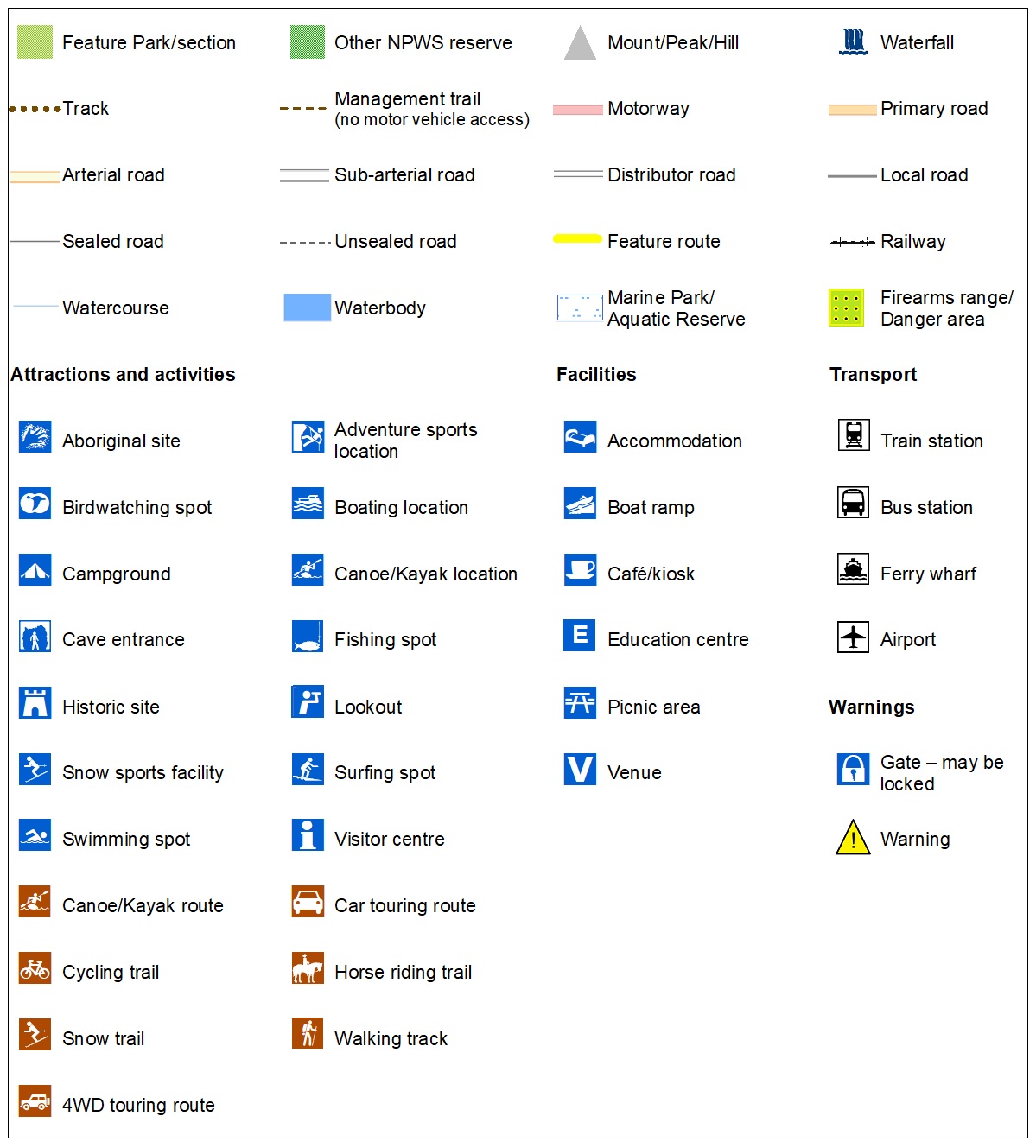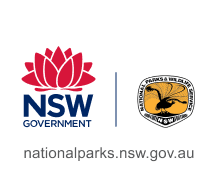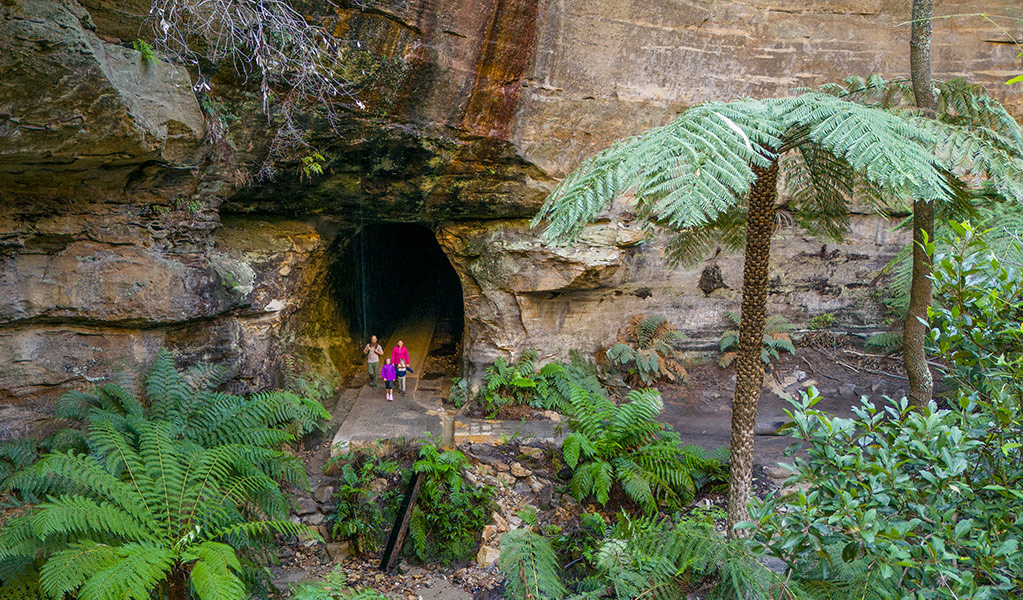Overview
Glow Worm Tunnel walking track is the fastest and easiest way to experience the wonder of this historic tunnel, lit by thousands of glow worms. It’s a favourite with visitors to Wollemi National Park, near Lithgow.
- Accessibility
- No wheelchair access
- Distance
- 6km return
- Time suggested
- 2 - 3hrs
- Grade
- Grade 3
- What to
bring - Hat, sunscreen, raincoat, snacks, drinking water, sturdy shoes, suitable clothing, torch
- Please note
- Glow Worm Tunnel is home to thousands of glow worms. Help protect them by staying on the path.
- Please take care in the tunnel as it’s completely dark and the ground can be slippery.
- When you turn off your torch, take the time for your eyes to adjust to the darkness before you see the glow worms.
- Try to keep noise to a minimum as glow worms are sensitive to sound.
- Shine your torch on the ground or use one with a red-light option as red-light is the least disruptive for glow worms.
- It’s best to visit during the week or in spring or autumn. It can be very busy and there’s limited parking during summer, weekends, and holiday periods.
- Please stay on the walking tracks to protect this World Heritage Area.
- The Glow Worm Tunnel to Newnes section of the track may be closed during or after heavy rain because of rock fall and flood risk. Please check alerts for track closures before you leave home.
- The track beyond the lookout is not suitable for children.
Glow Worm Tunnel walking track is a short and easy 6km return walk. Just a 2.5hr drive from Sydney, it’s popular with families and anyone keen to see glow worms in their natural environment.
The track starts from the carpark at the end of Glowworm Tunnel Road. Enjoy the easy 1.5km walk to the tunnel entrance, past an impressive landscape of tall forests, lush tree ferns, narrow gorges and stunning pagoda rock formations.
The 387metre-long tunnel was built in the early 1900s as part of the railway for the thriving mining industry at Newnes. It’s now home to thousands of glow worms that cling to the dark, damp walls. Because the tunnel is long, it gets dark enough to see glow worms during the day. Upgrades to the walking track to even out the surface and install a handrail make navigating in the dark easier. To see the glow worms, switch off your torch, keep quiet, and wait for them to light up the tunnel.
Once you reach the end of the tunnel, follow the track for another 1.5km though lush forests of eucalyptus, broad-leaved hickory and tree ferns in the wet gully environment of Penrose Gorge. Take a break at the lookout to see expansive views of Donkey Mountain and Wolgan Valley.
As you walk back the way you came, look out for goannas and lyrebirds. During spring and summer, the walking track is dotted also with yellow pagoda daisies, while banksias bloom in the cooler months.
You can listen and learn about railway heritage and glow worms as you see them along the walk with our self-guided audio tour. Download the tour before you leave home to listen to the tour offline as there isn’t any mobile reception along the walk.
Also see
-

Glow Worm Tunnel self-guided audio tour
Discover the fascinating history of the Glow Worm Tunnel on this self-guided audio tour in Wollemi National Park. You’ll follow the bed of the old Wolgan Valley Railway line to Tunnel No. 2, now home to thousands of glow worms.
-

Life and light in Glow Worm Tunnel
Glow Worm Tunnel is a habitat for glow worms and an enchanting walk for visitors. Watch our videos to learn how an old railway tunnel from the days of oil shale mining has taken on a new life.
-

Glow Worm Tunnel via Wolgan Valley loop
Set aside a day to hike 9km through Wollemi National Park on Glow Worm Tunnel via Wolgan Valley loop. Marvel at the historic railway tunnel, a lush rainforest gorge, and rocky pagoda outcrops, on this special walk between Newnes and Lithgow.
Map

Map

Map legend

Local alerts
For the latest updates on fires, closures and other alerts in this area, see https://www.nationalparks.nsw.gov.au/things-to-do/walking-tracks/glow-worm-tunnel-walking-track/local-alerts
General enquiries
- National Parks Contact Centre
- 7am to 7pm daily
- 1300 072 757 (13000 PARKS) for the cost of a local call within Australia excluding mobiles
- parks.info@environment.nsw.gov.au
Park info
- in Wollemi National Park in the Sydney and surrounds, North Coast and Country NSW regions
Wollemi National Park is always open but may have to close at times due to poor weather or fire danger.
Visitor info
All the practical information you need to know about Glow Worm Tunnel walking track.
Track grading
Features of this track
Distance
6km return
Time
2 - 3hrs
Quality of markings
Sign posted
Experience required
Some bushwalking experience recommended
Gradient
Short steep hills
Quality of path
Formed track, some obstacles: The track is 1-2m-wide and hard-packed ground with sections of uneven stone ground.
Steps
Occasional steps: At around 700m along the track, you'll arrive at the first of over 80 steps:
- There are around 30 stone steps with no handrail that go down to a bridge
- There's another 30 narrow, winding timber steps with no handrail that lead back up the track
- After this, there are occasional stone steps along the track in groups of 2-3.
Other barriers
Pinch points: The track narrows to 0.5m-wide just before the set of winding timber steps after the bridge.
Other barriers:
- There's a barrier at the trail-head with a 1m wide gap for walkers to get around it.
- The glow worm tunnel at the end of the walk is uneven and rocky. The ground may be wet.
Getting there and parking
Glow Worm Tunnel walking track is in the Lithgow area of Wollemi National Park. To get there:
Directions from Lithgow via Clarence
- Take the B59 (Chifley Road) to Clarence (Zig Zag Railway).
- Turn left at Petra Avenue and continue onto Old Bells Line of Road for 8.4 km.
- At the end of Old Bells Line of Road, turn right onto Glowworm Tunnel Road. Continue for 26.8km.
- You will drive through a 60m long single lane tunnel just before you reach the Glow Worm Tunnel Carpark.
Directions from Lithgow, via State Mine Gully Road (check Local Alerts as roads may be closed for infrastructure upgrades)
- The route is signposted from the corner of Bridge Street and Main Street Lithgow.
- From Bridge Street, turn right at Inch Street.
- Turn left at Atkinson Street and after 750m, turn right onto State Mine Gully Road. State Mine Gully Road is a gravel road that becomes Glowworm Tunnel Road.
- After about 39km, you’ll drive through a 60m tunnel just before you reach the Glow Worm Tunnel car park.
Road conditions and access
- Trucks frequently use Old Bells Line of Road for infrastructure works. Please drive carefully.
- State Mine Gully Road and Glowworm Tunnel Road is an unsealed gravel road in Gardens of Stone State Conservation Area. While 2WD vehicles can access this route in dry weather, 4WD vehicles are highly recommended. Access is by 4WD only in wet weather.
- Please drive carefully on the narrow gravel roads, and look out for wildlife.
- Unsealed roads
Vehicle access
- 2WD vehicles (no long vehicle access)
Weather restrictions
- 4WD required in wet weather
Parking
- The carpark is at the end of Glowworm Tunnel Road, 1.5km from the Glow Worm Tunnel. Car spaces are limited during peak times.
- You can also park at the Old Coach Road carpark and walk along the Pagoda walking track and connect with Glow Worm Tunnel walking track (4km return).
Facilities
- Drinking water is not available in this area so you’ll need to bring your own.
- Please take all rubbish with you when you leave.
Toilets
There's a toilet block with 2 non-flush toilets. One of the toilets is an ambulant toilet.
- Non-flush toilets
Carpark
Seats and resting points
There's a timber bench with a backrest at the very start of walk, next to the carpark and display shelter. There are no other seats or resting points along this walk.
Maps and downloads
Accessibility
Disability access level - no wheelchair access
Glow Worm Tunnel walking track is not suitable for wheelchairs or prams and may be challenging for people with reduced mobility:
- There are over 80 steps without handrails along the walk
- The track is uneven hard-packed ground and stone
- There's a point where the track narrows to 0.5m-wide after the bridge and before the winding timber steps
- The glow worm tunnel at the end of the walk is uneven and rocky
There's an ambulant toilet and a timber bench for resting at the start of the walk.
Prohibited
Camping
Camping is not permitted in the Glow Worm Tunnel area. The nearest campground is Newnes campground, which is accessed via Wolgan Valley Road.
Cycling
Cycling is not permitted along this walking track or in the Glow Worm Tunnel. You can cycle on Glowworm Tunnel Road.
Pets
Pets and domestic animals (other than certified assistance animals) are not permitted. Find out which regional parks allow dog walking and see the pets in parks policy for more information.
Smoking
NSW national parks are no smoking areas.
Learn more
Glow Worm Tunnel walking track is in Wollemi National Park. Here are just some of the reasons why this park is special:
Ancient connections

The area that is now Wollemi National Park has held significance to Aboriginal people for at least 12,000 years. Evidence of this connection can be seen throughout the park, including ceremonial grounds, stone arrangements, grinding grooves, scarred trees and rock engravings. There are around 120 known Aboriginal sites in the park and probably many more yet to be discovered. The Wiradjuri, Dharug, Wanaruah and Darkinjung people have a strong and ongoing cultural association with their traditional lands and waters.
- Ganguddy-Dunns Swamp guided Aboriginal cultural tour Join Wirimbili Cultural Experience on a guided walk through Ganguddy-Dunns Swamp. Learn about local Aboriginal culture and tradition as you explore Wollemi National Park, near Rylstone.
- Guided kayak tours of Ganguddy-Dunns Swamp Experience the natural beauty of escarpments, gorges and wildlife on a guided paddling tour of Gunguddy-Dunns Swamp with Southern Cross Kayaking.
- Pagoda Lookout walking track Pagoda Lookout walking track is a short but steep walk near Rylstone in Wollemi National Park. Enjoy incredible views over ancient pagoda rock formations and the Cudgegong River.
Geological marvels

Wollemi's landscape has been sculpted over millennia into a magnificent network of soaring sandstone escarpments, plunging gorges and canyons, winding river valleys and awe-inspiring geological and geomorphological features such as pagoda rock formations, basalt-capped mountains and diatremes. The spectacular Colo gorge and its tributaries form the most extensive sandstone canyon system in eastern Australia. Grab your camera and discover for yourself the breathtaking vistas and natural marvels that make this a World Heritage treasure.
- Explore Wollemi's wonders guided tour Experience the highlights of Wollemi National Park on this guided tour with Hikeandseek NSW. Traverse canyons, tunnels and valleys while learning about the area’s history.
- Glow Worm Tunnel self-guided audio tour Discover the fascinating history of the Glow Worm Tunnel on this self-guided audio tour in Wollemi National Park. You’ll follow the bed of the old Wolgan Valley Railway line to Tunnel No. 2, now home to thousands of glow worms.
- Guided kayak tours of Ganguddy-Dunns Swamp Experience the natural beauty of escarpments, gorges and wildlife on a guided paddling tour of Gunguddy-Dunns Swamp with Southern Cross Kayaking.
- Pagoda Lookout walking track Pagoda Lookout walking track is a short but steep walk near Rylstone in Wollemi National Park. Enjoy incredible views over ancient pagoda rock formations and the Cudgegong River.
- Wollemi camping and canyoning expeditions Join Roam Adventures and Training on a camping and canyoning adventure in the stunning Wollemi National Park.
Nature's haven

It's little surprise that Wollemi's spectacular landscape shelters a rich diversity of plants and animals. The rare Wollemi pine - a 'living fossil' whose closest relatives thrived some 90 million years ago was rediscovered here in 1994, and the park protects an incredible array of botanical species and communities, from open eucalypt forest and woodlands including Hawkesbury and grey box, to rainforests and perched swamps. This variety makes it an appealing habitat for eastern grey kangaroos, red-necked wallabies and the elusive brush-tailed rock wallaby, as well as the beautifully marked broad-headed snake, regent honeyeater and glossy black cockatoo. Around 55 species of butterfly have also been recorded.
- Glow Worm Tunnel self-guided audio tour Discover the fascinating history of the Glow Worm Tunnel on this self-guided audio tour in Wollemi National Park. You’ll follow the bed of the old Wolgan Valley Railway line to Tunnel No. 2, now home to thousands of glow worms.
- Glow Worm Tunnel via Wolgan Valley loop Set aside a day to hike 9km through Wollemi National Park on Glow Worm Tunnel via Wolgan Valley loop. Marvel at the historic railway tunnel, a lush rainforest gorge, and rocky pagoda outcrops, on this special walk between Newnes and Lithgow.
Outdoor adventure

Pitch a tent at one of Wollemi's great campgrounds, like the secluded Colo Meroo backpack campground, the car-accessible Coorongooba campground or the dramatically-situated, car-accessible Newnes campground. With your base set up, you're free to get out and enjoy the park's fantastic outdoor attractions, be they more relaxed pursuits such as picnicking, canoeing and swimming or something more adventurous like rock climbing, horseriding and hiking.
Plants and animals protected in this park
Animals
-

Glow worms (Arachnocampa richardsae)
Glow worms are the larval life stage of small flying insects. They live in dark, damp caves and rainforest gullies and are best-known for the starry, bioluminescent glow of their colonies.
-

Superb lyrebird (Menura novaehollandiae)
With a complex mimicking call and an elaborate courtship dance to match, the superb lyrebird is one of the most spectacular Australian animals. A bird watching must-see, the superb lyrebird can be found in rainforests and wet woodlands across eastern NSW and Victoria.
-

Bare-nosed wombat (Vombatus ursinus)
A large, squat marsupial, the Australian bare-nosed wombat is a burrowing mammal found in coastal forests and mountain ranges across NSW and Victoria. The only other remaining species of wombat in NSW, the endangered southern hairy-nosed wombat, was considered extinct until relatively recently.
-

Southern boobook (Ninox novaeseelandiae)
The southern boobook, also known as the mopoke, is the smallest and most common native owl in Australia. With a musical 'boo-book' call that echoes through forests and woodlands, the southern boobook is a great one to look out for while bird watching.
-

Satin bowerbird (Ptilonorhynchus violaceus)
With vibrant blue-violet eyes and curious antics, the satin bowerbird is a favourite for bird watching and easy to spot as it forages for food in open forest. Relatively common across eastern Australia, in NSW they’re found in coastal rainforests and adjacent woodlands and mountain ranges.
-

Spotted-tailed quoll (Dasyurus maculatus)
The spotted-tailed quoll is the largest remaining carnivorous marsupial on the Australian mainland. It’s protected as a vulnerable species in NSW.
Plants
-

Wollemi pine (Wollemia nobilis)
The Wollemi pine is one of the world’s oldest and rarest trees. Only 46 adult trees and 43 juveniles remain in the wild. Belonging to a 200 million year-old plant family, this critically endangered Australian species is considered a global treasure.
-

Smooth-barked apple (Angophora costata)
Smooth-barked apple gums, also known as Sydney red gum or rusty gum trees, are Australian native plants found along the NSW coast, and in the Sydney basin and parts of Queensland. Growing to heights of 15-30m, the russet-coloured angophoras shed their bark in spring to reveal spectacular new salmon-coloured bark.
Environments in this park
General enquiries
- National Parks Contact Centre
- 7am to 7pm daily
- 1300 072 757 (13000 PARKS) for the cost of a local call within Australia excluding mobiles
- parks.info@environment.nsw.gov.au
Operated by
- Blue Mountains Heritage Centre and Blackheath office
- 9am to 4pm daily. Closed Christmas Day.
- 02 4787 8877
- bluemountains.heritagecentre@environment.nsw.gov.au
- 270 Govetts Leap Road, Blackheath NSW 2785
Park info
- in Wollemi National Park in the Sydney and surrounds, North Coast and Country NSW regions
Wollemi National Park is always open but may have to close at times due to poor weather or fire danger.
What's nearby:
Things to do (16)
- 4WD touring (1)
- Aboriginal culture (1)
- Adventure sports (3)
- Birdwatching and wildlife encounters (1)
- Cycling (2)
- Historic heritage (5)
- Horse riding (2)
- Sightseeing (4)
- Walking (5)
- Waterfalls (2)

